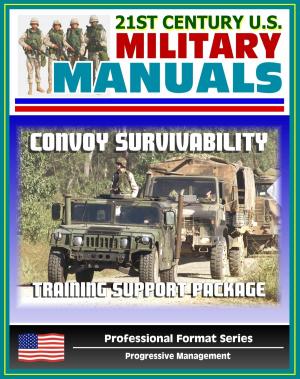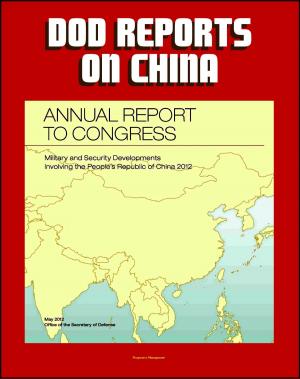Fire in the City: Airpower in Urban, Smaller-Scale Contingencies (USSC) - Case Studies of Hue 1968, Siege of Beirut 1982, Operation Just Cause 1989, UNOSOM Somalia, Uphold Democracy 1994
Nonfiction, History, Military, Vietnam War, Asian, Strategy| Author: | Progressive Management | ISBN: | 9781311600202 |
| Publisher: | Progressive Management | Publication: | June 1, 2016 |
| Imprint: | Smashwords Edition | Language: | English |
| Author: | Progressive Management |
| ISBN: | 9781311600202 |
| Publisher: | Progressive Management |
| Publication: | June 1, 2016 |
| Imprint: | Smashwords Edition |
| Language: | English |
This excellent report has been professionally converted for accurate flowing-text e-book format reproduction. This study examines the roles and missions of airpower in urban operations in smaller-scale contingencies. Urban operations, often referred to as military operations on urbanized terrain (MOUT), are some of the most complex and difficult missions currently facing the US military. Smaller-scale contingencies introduce the challenge of significant political constraints and an increasing intolerance for casualties and collateral damage. To capture the difficulty of urban combat, the study concentrates on cases where combat operations were either conducted or planned.
The study examines five cases in which airpower, including land and carrier based aircraft as well as helicopters, was involved. The cases include the battle for Hue during the Vietnam War, the Israeli siege of Beirut in Lebanon, Operation Just Cause, the US invasion of Panama, UNISOM II in Somalia, and Operation Uphold Democracy in Haiti.
Mobility, in the form of strategic airlift and helicopter mobility, was generally the most important airpower contribution to urban, smaller-scale contingencies. Additionally, surface attack was decisive in some cases and helped to limit casualties and collateral damage in others. Other airpower missions, such as command, control, communications, intelligence, surveillance, reconnaissance, and information operations supported urban operations. Additionally, the case studies suggest that airpower can, under certain circumstances, coerce an adversary into complying with our demands.
The cases also show that any misuse of, or failure to fully exploit the capabilities of, airpower can lead to dire consequences such as higher casualties, increased collateral damage, and mission failure.
Chapter 1 - INTRODUCTION * Why are Urban, Smaller Scale Contingencies Important? * International Political Considerations * The Challenge * Is the US military adequately prepared for USSCs? * Framing the Debate * Chapter 2 - HUE, 1968 * The Role of Airpower * Airpower Missions * Airlift * Airpower Lessons * Capabilities * Operational Missions/Tactical Tasks * Collateral Damage * Chapter 3 - THE SIEGE OF BEIRUT, 1982 * Background * Operations * The Siege of Beirut * The Role of Airpower * Missions * Airlift * Air Superiority * Surface Attack * Information Operations * Airpower Lessons * Capability * Survivability * Chapter 4 - OPERATION JUST CAUSE, PANAMA, 1989 * Background Operations * The Comandancia * Paitilla Airfield * Torrijos/Tocumen International Airport * Pacora River bridge * Rio Hato * The Role of Airpower * Missions * Airlift * Inflight Refueling * Surface Attack * Communications, Command, Control, and Reconnaissance * Information Operations * Airpower Lessons * Capability * Operations * Survivability * Chapter 5 - UNOSOM II, SOMALIA * Background * Operations * The Role of Airpower * Airpower Missions * Airlift * Inflight Refueling * Surface Attack * Information Operations * Communications, Command, Control, and Reconnaissance * Airpower Lessons * Capability * Survivability * Chapter 6 - OPERATION UPHOLD DEMOCRACY, HAITI, 1994 * Background * Operations * The Role of Airpower * Missions * Airlift * Air Superiority * Inflight Refueling * Surface Attack * Communications, Command, Control, and Reconnaissance * Information Operations * Airpower Lessons * Chapter 7 - CONCLUSIONS AND RECOMMENDATIONS * Airpower Roles * Mission Essential * Mission Critical * Mission Support * Strategic Coercion * Operational and Tactical Coercion * Opportunities Lost * Future Opportunities * Summary * Recommendations * Adverse Weather Capability * Survivability * Weapons * Breaking the Paradigm
This excellent report has been professionally converted for accurate flowing-text e-book format reproduction. This study examines the roles and missions of airpower in urban operations in smaller-scale contingencies. Urban operations, often referred to as military operations on urbanized terrain (MOUT), are some of the most complex and difficult missions currently facing the US military. Smaller-scale contingencies introduce the challenge of significant political constraints and an increasing intolerance for casualties and collateral damage. To capture the difficulty of urban combat, the study concentrates on cases where combat operations were either conducted or planned.
The study examines five cases in which airpower, including land and carrier based aircraft as well as helicopters, was involved. The cases include the battle for Hue during the Vietnam War, the Israeli siege of Beirut in Lebanon, Operation Just Cause, the US invasion of Panama, UNISOM II in Somalia, and Operation Uphold Democracy in Haiti.
Mobility, in the form of strategic airlift and helicopter mobility, was generally the most important airpower contribution to urban, smaller-scale contingencies. Additionally, surface attack was decisive in some cases and helped to limit casualties and collateral damage in others. Other airpower missions, such as command, control, communications, intelligence, surveillance, reconnaissance, and information operations supported urban operations. Additionally, the case studies suggest that airpower can, under certain circumstances, coerce an adversary into complying with our demands.
The cases also show that any misuse of, or failure to fully exploit the capabilities of, airpower can lead to dire consequences such as higher casualties, increased collateral damage, and mission failure.
Chapter 1 - INTRODUCTION * Why are Urban, Smaller Scale Contingencies Important? * International Political Considerations * The Challenge * Is the US military adequately prepared for USSCs? * Framing the Debate * Chapter 2 - HUE, 1968 * The Role of Airpower * Airpower Missions * Airlift * Airpower Lessons * Capabilities * Operational Missions/Tactical Tasks * Collateral Damage * Chapter 3 - THE SIEGE OF BEIRUT, 1982 * Background * Operations * The Siege of Beirut * The Role of Airpower * Missions * Airlift * Air Superiority * Surface Attack * Information Operations * Airpower Lessons * Capability * Survivability * Chapter 4 - OPERATION JUST CAUSE, PANAMA, 1989 * Background Operations * The Comandancia * Paitilla Airfield * Torrijos/Tocumen International Airport * Pacora River bridge * Rio Hato * The Role of Airpower * Missions * Airlift * Inflight Refueling * Surface Attack * Communications, Command, Control, and Reconnaissance * Information Operations * Airpower Lessons * Capability * Operations * Survivability * Chapter 5 - UNOSOM II, SOMALIA * Background * Operations * The Role of Airpower * Airpower Missions * Airlift * Inflight Refueling * Surface Attack * Information Operations * Communications, Command, Control, and Reconnaissance * Airpower Lessons * Capability * Survivability * Chapter 6 - OPERATION UPHOLD DEMOCRACY, HAITI, 1994 * Background * Operations * The Role of Airpower * Missions * Airlift * Air Superiority * Inflight Refueling * Surface Attack * Communications, Command, Control, and Reconnaissance * Information Operations * Airpower Lessons * Chapter 7 - CONCLUSIONS AND RECOMMENDATIONS * Airpower Roles * Mission Essential * Mission Critical * Mission Support * Strategic Coercion * Operational and Tactical Coercion * Opportunities Lost * Future Opportunities * Summary * Recommendations * Adverse Weather Capability * Survivability * Weapons * Breaking the Paradigm















